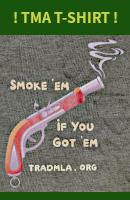I asked them about Hawken flinters and they said there is no known example of one and no mention of one in the Hawken records. So like Rollingb says any flint Hawkens are fantasy rifles until they can be verified by a prime source.
With respect, but some of the info being passed on by folks including some posted on the Hawken Shoppe site is old and/or incorrect info:
1) The Smithsonian Hawken has been verified by certain knowledgeable folks to be a conversion from flint to percussion and it was built in the 1850's, some 25-30 years after the brothers joined forces. There are some "experts"who dispute this, but none that I know have actually inspected the rifle in person, rather they base their assertion on the known photos and their own "prejudices". There are also a couple of other conversions that have not been verified, but are very good possibilities (see below).
2) Regarding documentation:
Charles Hanson wrote his book about the brothers Hawken back in 1983, and unfortunately far too many people have accepted it as the final word, something the good doctor warned against. Plus some of his arguments/conclusions are not based on the best scholarship, something he also warned about, yet did himself.
Since then more info has come to light - for instance:
1) Dr. Hansen stated that there were no records of a Hawken ever going to rendezvous. Documentation has now been published showing that in at least three years: 1834, 1836, & 1837, several Hawken rifles did in fact go to rendezvous.
2) He pictured a pre-1825 Sam Hawken made flinter and stated that at that time it was the only one known. Since then several others have come to light. Due to their eastern styling, many consider that these rifles are pre-St. Louis guns, but the fact is they can just as easily have been made between 1822-1825 when Sam first arrived in St. Louis.
This brings up a point that is rarely discussed. For whatever reasons it is commonly envisioned that the Hawken brothers, both of whom had been trained in the Maryland school of long rifles, which are eastern brass mounted flinters, suddenly upon arrival in St. Louis began making what we now consider to be a typical Hawken - iron mounted half-stocks or full stocks in percussion.
What facts we do have, including a few, very few early "transitional" rifles, show that the style developed over time and was not an immediate change from their previous work, just like most other makers.
3) Dr. Hansen also stated that the brass mounted flint Hawken described by George Ruxton in 1846, which he said dated from 1825, was likely a fabrication since he knew of no brass mounted Hawken mountain rifles - but there are in fact a few brass mounted Hawken mountain rifles still in existence, including a J & S Hawken with a converted flintlock and an 1850's period S. Hawken full stock with a converted flintlock. I can supply photos if anyone would like to see tham.
As for the records - unfortunately the records are extremely sparse for the era prior to 1831, a time when flinters were far more popular than percussion guns. Even through most of the 1830's percussion guns, while they did get used in the far west, were not popular until after 1840. For instance the Henry's Bolton Gun works didn't start supplying percussion guns to the fur companies until 1840.
Secondl some more records have come to light since 1983 and give a more complete picture. Also - Dr Hansen used a fairly limited set of fur trade records and they were far from complete. This includes his commonly quoted chart of sales which is based only on sales to the fur companies and does not include the known tax records for 1850, a year in which Sam paid taxes on 100 rifles produced, thus skewing the history of sales.
The brothers as individuals were in business in St Louis, from 1818 (Jake the elder brother) and 1822 (Sam). Both dates are well before the percussion lock was popular and even the 1825 date of their partnership is several years before percussion guns became popular in the west. Did they stop making guns during a period in which flinters were still king, and only begin when the percussion became popular? In fact the few records still in existence do document that they made guns during the flinter years.
So is a flint Hawken a fantasy? With respect, IMO no since fantasy implies an item made up without any substance in reality, yet the records, while not complete, as well as other circumstantial evidence, implies other wise.
The Hawkens, both as individuals and in partnership, were like most small shops of the time a custom shop, where a customer could order a gun as he desired. And yes like most small shops of the time they also did repair work and general blacksmithing, but nothing in the records indicates they did not make any rifles, in fact just the opposite.
Flint Hawkens IMO are akin to the the pre-1760 American made rifles - we know they existed, but to date there are no known surviving examples - are they then fantasy too?
On the other hand, as noted above, there are other verifiable flint rifles that went west with the trappers:
The iron mounted Southern rifles and the iron mounted Henry Lancaster for example. Unfortunately for the latter we have no known existing examples, only written records. The one shown in Hansen and other books is not a Henry - it has a Henry barrel and IIRC lock, but the rifle itself was made in NC, by an unknown maker.
Other options are the brass mounted Lancaster style trade rifle as made by Dickert, Gomph, Henry (the most prolific post 1826), and others, including Leman, who was a late comer to the western fur trade - his company's first recorded rifles going to a fur company are post 1840.
Don Stith, whose site I noted above, has been working on a good copy of the Henry and while they are not listed yet on his site, he has sold a kit or two. I'm not sure how much farther he's gone in developing the kits for sale because he hasn't gotten as much interest in them as he'd like to before expending the time and energy - so for those interested in a copy of such a fur trade rifle I'd let Don know. He's also a heck of a nice guy and is one the most knowledgeable people regarding Hawkens in particular, and muzzleloaders of the west in general. He not only owns original Hawkens, from which some of kits are based on and has inspected many, many more - The only way really to understand the nuances in construction which make the Hawken a genuine Hawken and not some other make and something that Don is willing to pass on, usually free of charge.
While not perfect one of the best books available on firearms in the west is "Firearms of the American West: 1803-1865" by Garavaglia and Worman. It contains some older info that has since been updated, but it also contains a lot of primary documentation for the time and place.
And yes handling the old guns is special, I've had the pleasure of handling/inspecting first hand a dozen Hawkens over the years, including the Bridger and the Modena/Medina ones........and if I sound passionate about Hawknes it is because I am, but my passion does not blind me to the facts either, but much of the info available is older and has either been refuted and/or added to - unfortunately much of it is only available by talking with the folks in the know, like Don Stith, most of whom seldom write about it





